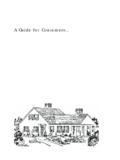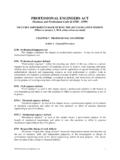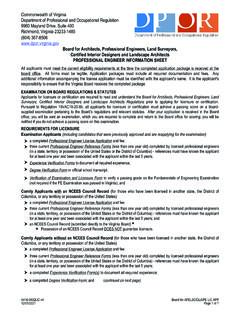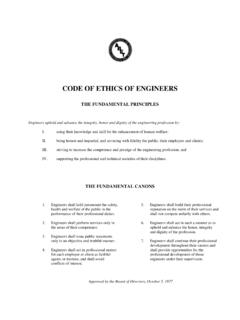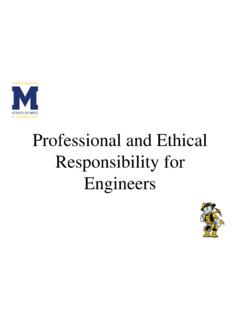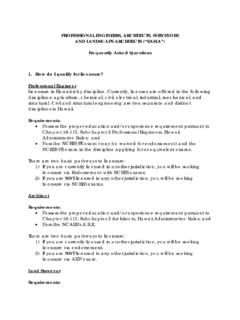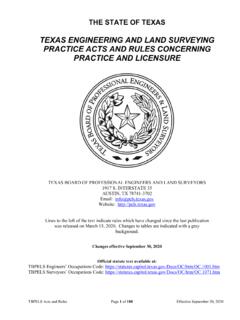Transcription of Professional Engineering Body of Knowledge
1 Professional Engineering body of Knowledge Prepared by the Licensure and Qualifications for Practice Committee of the National Society of Professional Engineers first edition, 2013. Professional Engineering body of Knowledge Prepared by the Licensure and Qualifications for Practice Committee of the National Society of Professional Engineers First Edition, 2013. Contents Executive Summary The body of Knowledge Concept ..4. The Engineering body of Knowledge ..4. Uses of the Engineering body of Knowledge ..5. Chapter 1 Introduction NSPE's Vision, Mission, and Values ..6. Charge Undertaken by the NSPE Licensure and Qualifications for Practice Committee ..6. The Process Used ..7. Chapter 2 The body of Knowledge Concept Definitions ..9. Uses of the Engineering body of Knowledge ..9. Chapter 3 The Professional engineer of the Future Guiding Principles that Will Shape the Future of Engineering ..11. Key Attributes of the Professional engineer of the Future ..12. Chapter 4 The Engineering body of Knowledge Definition of Entry into Professional Engineering Practice.
2 13. Use of Capabilities to Describe the body of Knowledge ..13. Overview of the Capabilities ..14. Chapter 5 The Next Steps ..19. Acknowledgements ..20. APPENDIX A Abbreviations ..21. APPENDIX B National Society of Professional Engineers Licensure and Qualifications for Practice Committee 2012 13 ..24. 2. APPENDIX C Engineering Disciplines ..26. APPENDIX D The body of Knowledge Necessary for Entry into the Professional Practice of Engineering Expressed as Capabilities Basic or Foundational Capabilities ..28. Technical Capabilities ..32. Professional Practice Capabilities ..48. APPENDIX E Notes ..59. 3. Executive Summary The National Society of Professional Engineers (NSPE) Engineering body of Knowledge (BOK). initiative was undertaken in support of the Society's vision, mission, and values and in recognition of the need to proactively prepare for and participate in continuous changes in technological, social, cultural, political, and economic conditions. The charge undertaken by NSPE's Licensure and Qualifications for Practice Committee (LQPC) included reviewing recent key publications and then developing, while interacting with various stakeholders within and outside of NSPE, an Engineering BOK common to all Engineering disciplines.
3 As suggested by the charge and consistent with NSPE's vision, mission, and values, the Engineering BOK project and the resulting report are about the future. Given the uniqueness of this effort, including its future orientation and its intent to encompass all Engineering disciplines, this report should be viewed as an aspirational and living document. It stimulated interdisciplinary discussions during its preparation and is expected to encourage continued conversations now that it is published and widely available. Those interactions are very likely to eventually require a subsequent edition of the Engineering BOK. The body of Knowledge Concept A profession's BOK is its common intellectual ground it is shared by everyone in the profession regardless of employment or Engineering discipline. The Engineering BOK, as used in this report, is defined as the depth and breadth of Knowledge , skills, and attitudes appropriate to enter practice as a Professional engineer in responsible charge of Engineering activities that potentially impact public health, safety, and welfare.
4 Within the BOK: Knowledge consists of comprehending theories, principles, and fundamentals;. Skills are the abilities to perform tasks and apply Knowledge ; and Attitudes are the ways in which one thinks and feels in response to a fact or situation. In broad terms, Knowledge is what one knows in a fundamental sense, skill is what one is able to do with what one knows, and attitude is how one responds to a variety of situations. The Engineering body of Knowledge For the purposes of the Engineering BOK, the Knowledge , skills, and attitudes are referred to as capabilities. A capability is defined as what an individual is expected to know and be able to do by the time of entry into Professional practice in a responsible role. A given capability typically consists of many diverse and specific abilities. 4. Each capability is usually acquired by a combination of Engineering education and experience. NSPE will not be teasing apart what aspects or parts of the capabilities are fulfilled through education or experience because these means may vary significantly across disciplines and employment circumstances.
5 The names of 30 capabilities comprising the recommended Engineering BOK are listed here. They are organized for clarity into three categories, namely, Basic or Foundational, Technical, and Professional Practice. To reiterate, these are the names of the capabilities. The names are just that, they do not describe the capabilities. Refer to Appendix D for a description of each capability along with examples of supporting abilities. Basic or Foundational Capabilities: 1. Mathematics, 2. Natural Sciences, 3. Humanities and Social Sciences Technical Capabilities: 4. Manufacturing/Construction, 5. Design, 6. Engineering Economics, 7. Engineering Science, 8. Engineering Tools, 9. Experiments, 10. Problem Recognition and Solving, 11. Quality Control and Quality Assurance, 12. Risk, Reliability, and Uncertainty, 13. Safety, 14. Societal Impact, 15. Systems Engineering , 16. Operations and Maintenance, 17. Sustainability and Environmental Impact, 18. Technical Breadth, 19.
6 Technical Depth Professional Practice Capabilities: 20. Business Aspects of Engineering , 21. Communication, 22. Ethical Responsibility, 23. Global Knowledge and Awareness, 24. Leadership, 25. Legal Aspects of Engineering , 26. Lifelong Learning, 27. Professional Attitudes, 28. Project Management, 29. Public Policy and Engineering , 30. Teamwork While the full BOK is intended to apply across the Engineering profession, each Engineering discipline and employment situation combination may focus on a certain subset of the capabilities. Preparing a profession-wide BOK for a profession as diverse as Engineering is challenging and worthwhile. Uses of the Engineering body of Knowledge The recommended Engineering BOK can be useful, in a variety of ways, to various members of the profession and those with whom they interact; it is not an abstract concept. More specifically, the Engineering BOK can be of value to prospective and current Engineering students, engineer interns and Professional engineers, Engineering mentors and supervisors, employers, Engineering and other faculty, accreditation leaders, and licensing and certification boards.
7 In preparing, publishing, and widely distributing this document NSPE hopes that individuals, such as those just listed here, and their organizations will be motivated to examine where they have been, are, and could go. More specifically, NSPE asks each Engineering discipline to use the Engineering BOK as another means of engaging its stakeholders in assessing the discipline's status and challenges and then contemplating options for moving forward to meet those challenges. 5. Chapter 1. Introduction NSPE's Vision, Mission, and Values The Vision1 of the National Society of Professional Engineers (NSPE) is to be the recognized voice and advocate of licensed Professional Engineers. In partnership with the State Societies, NSPE's Mission1 is to be the organization of licensed Professional Engineers (PEs) and engineer Interns (EIs) and, the mission goes on to state that NSPE enhances the image of its members and their ability to ethically and professionally practice Engineering and does this through education, licensure advocacy, leadership training, multidisciplinary networking, and outreach.
8 NSPE's Vision and Mission are supported by the following eight values1: 1. Protection of the public welfare above all other considerations;. 2. Ethical and competent practice of Engineering ;. 3. Innovation through the creative application of math, science, and Engineering ;. 4. The PE license as the highest standard of professionalism in Engineering ;. 5. Continuous learning for Professional growth;. 6. Growth in the number of licensed Professional engineers;. 7. Teamwork, unity, and fellowship of all PEs across all disciplines; and 8. Commitment to the future of the licensed Professional engineer . The NSPE Engineering body of Knowledge (BOK) initiative was undertaken in support of the Society's vision, mission, and values. More specifically, the Engineering BOK project as described in this report is linked to and supports all eight values. (Note: Abbreviations used in this report are listed in Appendix A.). Charge Undertaken by the NSPE Licensure and Qualifications for Practice Committee In 2011, the Licensure and Qualifications for Practice Committee (LQPC) of the NSPE (see Appendix B) took on the following charge: Review the National Academy of Engineering (NAE) book The engineer of 2020 and the Civil Engineering and Environmental Engineering BOK reports2,3,4 and determine which elements of these reports apply to all Engineering disciplines.
9 Prepare an outline of an Engineering BOK common to all Engineering disciplines, with broad topics listed in bullet form, in 2011 12;. 6. Obtain input on the outline from the NSPE Board of Directors, Professional Engineers in Private Practice (PEPP), Professional Engineers in Industry (PEI), Professional Engineers in Construction (PEC), Professional Engineers in Higher Education (PEHE), and the Legislative and Government Affairs Committee in spring 2012; and Confirm the value of preparing an Engineering BOK and schedule its preparation for, at minimum, a two-year 2012 13 process. As suggested by the charge and consistent with NSPE's vision, mission, and values, the Engineering BOK project and the resulting report are to be about the future, not the present. This aspirational initiative is about tomorrow's Engineering practitioners, not necessarily about today's, although many of the capabilities are applicable now for practice as a Professional engineer . Undoubtedly, there will be a need for both increased depth and breadth in each of these capabilities in the future.
10 This initiative envisions the capabilities of tomorrow's practicing Professional engineers. This project is intended to include all Engineering disciplines practiced in the See Appendix C for a list of Engineering disciplines recognized by ABET, the organization that accredits Engineering Finally, given the uniqueness of this effort, including its future orientation and its intent to encompass all Engineering disciplines, the resulting report this document should be viewed as a living document. It stimulated interdisciplinary discussions during its preparation and is expected to encourage continued conversations as it is disseminated. Those interactions are very likely to continue and to eventually require a subsequent edition of the Engineering BOK. The Process Used The Engineering BOK Subcommittee developed a draft Engineering BOK outline which was approved by the LQPC in March 2012 for internal review within NSPE. Comments were solicited from the NSPE Board of Directors, the NSPE Legislative and Government Affairs Committee, and various interest groups within NSPE.






